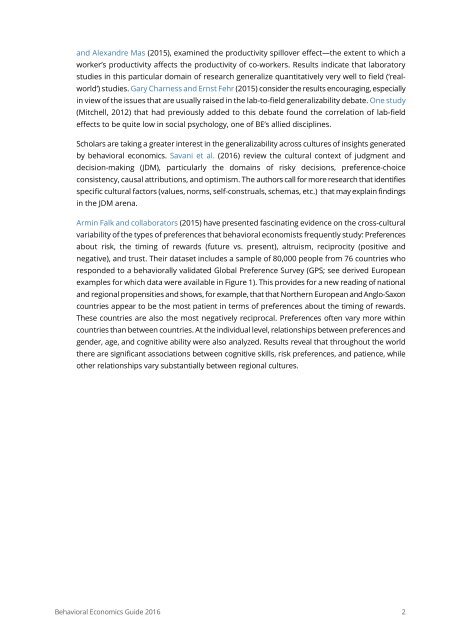THE BEHAVIORAL ECONOMICS GUIDE 2016
BEGuide2016
BEGuide2016
Create successful ePaper yourself
Turn your PDF publications into a flip-book with our unique Google optimized e-Paper software.
and Alexandre Mas (2015), examined the productivity spillover effect—the extent to which a<br />
worker’s productivity affects the productivity of co-workers. Results indicate that laboratory<br />
studies in this particular domain of research generalize quantitatively very well to field (‘realworld’)<br />
studies. Gary Charness and Ernst Fehr (2015) consider the results encouraging, especially<br />
in view of the issues that are usually raised in the lab-to-field generalizability debate. One study<br />
(Mitchell, 2012) that had previously added to this debate found the correlation of lab-field<br />
effects to be quite low in social psychology, one of BE’s allied disciplines.<br />
Scholars are taking a greater interest in the generalizability across cultures of insights generated<br />
by behavioral economics. Savani et al. (<strong>2016</strong>) review the cultural context of judgment and<br />
decision-making (JDM), particularly the domains of risky decisions, preference-choice<br />
consistency, causal attributions, and optimism. The authors call for more research that identifies<br />
specific cultural factors (values, norms, self-construals, schemas, etc.) that may explain findings<br />
in the JDM arena.<br />
Armin Falk and collaborators (2015) have presented fascinating evidence on the cross-cultural<br />
variability of the types of preferences that behavioral economists frequently study: Preferences<br />
about risk, the timing of rewards (future vs. present), altruism, reciprocity (positive and<br />
negative), and trust. Their dataset includes a sample of 80,000 people from 76 countries who<br />
responded to a behaviorally validated Global Preference Survey (GPS; see derived European<br />
examples for which data were available in Figure 1). This provides for a new reading of national<br />
and regional propensities and shows, for example, that that Northern European and Anglo-Saxon<br />
countries appear to be the most patient in terms of preferences about the timing of rewards.<br />
These countries are also the most negatively reciprocal. Preferences often vary more within<br />
countries than between countries. At the individual level, relationships between preferences and<br />
gender, age, and cognitive ability were also analyzed. Results reveal that throughout the world<br />
there are significant associations between cognitive skills, risk preferences, and patience, while<br />
other relationships vary substantially between regional cultures.<br />
Behavioral Economics Guide <strong>2016</strong> 2


